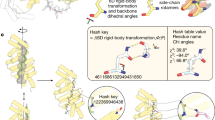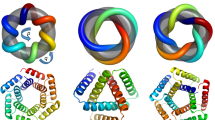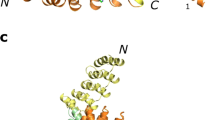Abstract
Shape complementarity is an important component of molecular recognition, and the ability to precisely adjust the shape of a binding scaffold to match a target of interest would greatly facilitate the creation of high-affinity protein reagents and therapeutics. Here we describe a general approach to control the shape of the binding surface on repeat-protein scaffolds and apply it to leucine-rich-repeat proteins. First, self-compatible building-block modules are designed that, when polymerized, generate surfaces with unique but constant curvatures. Second, a set of junction modules that connect the different building blocks are designed. Finally, new proteins with custom-designed shapes are generated by appropriately combining building-block and junction modules. Crystal structures of the designs illustrate the power of the approach in controlling repeat-protein curvature.
This is a preview of subscription content, access via your institution
Access options
Subscribe to this journal
Receive 12 print issues and online access
$189.00 per year
only $15.75 per issue
Buy this article
- Purchase on Springer Link
- Instant access to full article PDF
Prices may be subject to local taxes which are calculated during checkout




Similar content being viewed by others
References
Binz, H.K., Amstutz, P. & Pluckthun, A. Engineering novel binding proteins from nonimmunoglobulin domains. Nat. Biotechnol. 23, 1257–1268 (2005).
Skerra, A. Alternative non-antibody scaffolds for molecular recognition. Curr. Opin. Biotechnol. 18, 295–304 (2007).
Gebauer, M. & Skerra, A. Engineered protein scaffolds as next-generation antibody therapeutics. Curr. Opin. Chem. Biol. 13, 245–255 (2009).
Javadi, Y. & Itzhaki, L.S. Tandem-repeat proteins: regularity plus modularity equals design-ability. Curr. Opin. Struct. Biol. 23, 622–631 (2013).
Grove, T.Z., Regan, L. & Cortajarena, A.L. Nanostructured functional films from engineered repeat proteins. J. R. Soc. Interface 10, 20130051 (2013).
Phillips, J.J., Millership, C. & Main, E.R. Fibrous nanostructures from the self-assembly of designed repeat protein modules. Angew. Chem. Int. Edn Engl. 51, 13132–13135 (2012).
Han, S.H., Lee, M.K. & Lim, Y.B. Bioinspired self-assembled peptide nanofibers with thermostable multivalent α-helices. Biomacromolecules 14, 1594–1599 (2013).
Kobe, B. & Kajava, A.V. The leucine-rich repeat as a protein recognition motif. Curr. Opin. Struct. Biol. 11, 725–732 (2001).
Enkhbayar, P., Kamiya, M., Osaki, M., Matsumoto, T. & Matsushima, N. Structural principles of leucine-rich repeat (LRR) proteins. Proteins 54, 394–403 (2004).
Kim, H.M. et al. Crystal structure of the TLR4-MD-2 complex with bound endotoxin antagonist Eritoran. Cell 130, 906–917 (2007).
Parker, R., Mercedes-Camacho, A. & Grove, T.Z. Consensus design of a NOD receptor leucine rich repeat domain with binding affinity for a muramyl dipeptide, a bacterial cell wall fragment. Protein Sci. 23, 790–800 (2014).
Lee, S.C. et al. Design of a binding scaffold based on variable lymphocyte receptors of jawless vertebrates by module engineering. Proc. Natl. Acad. Sci. USA 109, 3299–3304 (2012).
Binz, H.K. et al. High-affinity binders selected from designed ankyrin repeat protein libraries. Nat. Biotechnol. 22, 575–582 (2004).
Forrer, P., Stumpp, M.T., Binz, H.K. & Pluckthun, A. A novel strategy to design binding molecules harnessing the modular nature of repeat proteins. FEBS Lett. 539, 2–6 (2003).
Grove, T.Z., Cortajarena, A.L. & Regan, L. Ligand binding by repeat proteins: natural and designed. Curr. Opin. Struct. Biol. 18, 507–515 (2008).
Main, E.R., Xiong, Y., Cocco, M.J., D'Andrea, L. & Regan, L. Design of stable alpha-helical arrays from an idealized TPR motif. Structure 11, 497–508 (2003).
Filipovska, A. & Rackham, O. Modular recognition of nucleic acids by PUF, TALE and PPR proteins. Mol. Biosyst. 8, 699–708 (2012).
Reichen, C., Hansen, S. & Pluckthun, A. Modular peptide binding: from a comparison of natural binders to designed armadillo repeat proteins. J. Struct. Biol. 185, 147–162 (2014).
Mak, A.N., Bradley, P., Cernadas, R.A., Bogdanove, A.J. & Stoddard, B.L. The crystal structure of TAL effector PthXo1 bound to its DNA target. Science 335, 716–719 (2012).
Ryou, J.H., Park, K., Lee, J.J., Kim, D. & Kim, H.S. Soluble expression of human glycoprotein Ibα in Escherichia coli through replacement of the N-terminal capping domain. Protein Expr. Purif. 101, 21–27 (2014).
Jung, K. et al. Toll-like receptor 4 decoy, TOY, attenuates gram-negative bacterial sepsis. PLoS ONE 4, e7403 (2009).
Parmeggiani, F. et al. A general computational approach for repeat protein design. J. Mol. Biol. 10.1016/j.jmb.2014.11.005.
Huang, P.S. et al. RosettaRemodel: a generalized framework for flexible backbone protein design. PLoS ONE 6, e24109 (2011).
Song, Y. et al. High-resolution comparative modeling with RosettaCM. Structure 21, 1735–1742 (2013).
Leaver-Fay, A. et al. ROSETTA3: an object-oriented software suite for the simulation and design of macromolecules. Methods Enzymol. 487, 545–574 (2011).
Sheffler, W. & Baker, D. RosettaHoles: rapid assessment of protein core packing for structure prediction, refinement, design, and validation. Protein Sci. 18, 229–239 (2009).
Park, B.S. & Lee, J.O. Recognition of lipopolysaccharide pattern by TLR4 complexes. Exp. Mol. Med. 45, e66 (2013).
Matsushima, N. & Miyashita, H. Leucine-rich repeat (LRR) domains containing intervening motifs in plants. Biomolecules 2, 288–311 (2012).
Wei, T. et al. LRRML: a conformational database and an XML description of leucine-rich repeats (LRRs). BMC Struct. Biol. 8, 47 (2008).
Bell, J.K. et al. The molecular structure of the Toll-like receptor 3 ligand-binding domain. Proc. Natl. Acad. Sci. USA 102, 10976–10980 (2005).
Park, B.S. et al. The structural basis of lipopolysaccharide recognition by the TLR4–MD-2 complex. Nature 458, 1191–1195 (2009).
Hothorn, M. et al. Structural basis of steroid hormone perception by the receptor kinase BRI1. Nature 474, 467–471 (2011).
Chen, R. & Weng, Z. A novel shape complementarity scoring function for protein-protein docking. Proteins 51, 397–408 (2003).
Gabb, H.A., Jackson, R.M. & Sternberg, M.J. Modelling protein docking using shape complementarity, electrostatics and biochemical information. J. Mol. Biol. 272, 106–120 (1997).
Lawrence, M.C. & Colman, P.M. Shape complementarity at protein/protein interfaces. J. Mol. Biol. 234, 946–950 (1993).
Jones, S. & Thornton, J.M. Principles of protein-protein interactions. Proc. Natl. Acad. Sci. USA 93, 13–20 (1996).
Fleishman, S.J. et al. Computational design of proteins targeting the conserved stem region of influenza hemagglutinin. Science 332, 816–821 (2011).
Procko, E. et al. Computational design of a protein-based enzyme inhibitor. J. Mol. Biol. 425, 3563–3575 (2013).
Epa, V.C. et al. Structural model for the interaction of a designed Ankyrin Repeat Protein with the human epidermal growth factor receptor 2. PLoS ONE 8, e59163 (2013).
Lee, J.J. et al. A high-affinity protein binder that blocks the IL-6/STAT3 signaling pathway effectively suppresses non-small cell lung cancer. Mol. Ther. 22, 1254–1265 (2014).
Nivón, L.G., Moretti, R. & Baker, D. A Pareto-optimal refinement method for protein design scaffolds. PLoS ONE 8, e59004 (2013).
Gibson, D.G. et al. Enzymatic assembly of DNA molecules up to several hundred kilobases. Nat. Methods 6, 343–345 (2009).
Otwinowski, Z. & Minor, W. Processing of X-ray diffraction data collected in oscillation mode. Methods Enzymol. 276, 307–326 (1997).
McCoy, A.J. et al. Phaser crystallographic software. J. Appl. Crystallogr. 40, 658–674 (2007).
Emsley, P. & Cowtan, K. Coot: model-building tools for molecular graphics. Acta Crystallogr. D Biol. Crystallogr. 60, 2126–2132 (2004).
Winn, M.D., Murshudov, G.N. & Papiz, M.Z. Macromolecular TLS refinement in REFMAC at moderate resolutions. Methods Enzymol. 374, 300–321 (2003).
Acknowledgements
We thank J. Bolduc for data collection for DLRR_A and the members of the protein production facility at the Institute for Protein Design for protein production. This work was supported by grants from the Howard Hughes Medical Institute (to D.B.), the Defense Threat Reduction Agency (HDTRA1-11-1-0041 to D.B.) and US National Institutes of Health (R01 GM49857 to B.L.S.). F.P. was supported as the recipient of a Swiss National Science Foundation Postdoctoral Fellowship (PBZHP3-125470) and a Human Frontier Science Program Long-Term Fellowship (LT000070/2009-L). This work was facilitated though the use of advanced computational, storage and networking infrastructure provided by the Hyak supercomputer system at the University of Washington.
Author information
Authors and Affiliations
Contributions
K.P. and D.B. conceived the project; K.P. performed the computational design with assistance from F.P. and P.-S.H.; K.P. expressed, purified and characterized the designs with assistance from F.P.; B.W.S. crystallized the designs and determined the structures; K.P. and D.B. drafted the manuscript with input from all authors; B.L.S. and D.B. supervised research.
Corresponding author
Ethics declarations
Competing interests
The authors declare no competing financial interests.
Integrated supplementary information
Supplementary Figure 1 Characterization of designed leucine-rich-repeat proteins.
(a) Water-mediate hydrogen-bond network is frequently visible in the convex region of LRR crystal structures. Examples are shown for the idealized L24 (DLRR_B) and L24→L28 fusion structure (DLRR_G3). Water molecules participating in the hydrogen bond (yellow dots) network are represented by spheres. (b) Super-helical shapes of the three idealized building block repeats. For clear visualization, dots tracing the global super-helix defined by the fitted parameters are overlaid with the LRR structures (rotation angle < 720°). The highly conserved leucine residues used for the parameter fitting are represented by spheres. See Supplementary Table 1 for the helical parameter estimation. (c) Structural alignments of the partial Ncap-L245 structure in DLRR_B (top) and L225 structure in DLRR_A (bottom) into the crystal structure of DLRR_E. Cα r.m.s. deviations for the alignments of DLRR_B and DLRR_A are 0.4 Å and 0.3 Å, respectively. (d) Structural defects in the initial fusion model of DLRR_G3. The crystal structure (magenta) of the junction module in DLRR_G3 is aligned with the initial model structure before design (gray) and the final model structure after design (green). The initial model contains large cavity and side chain clashes in the junction module, which are improved in the subsequent design procedure as shown in the final model structure (green). (e) SEC-MALS experiments for DLRR_D, DLRR_E, DLRR_I, DLRR_J, DLRR_K, and DLRR_L. Most of designs are monomeric even though some soluble aggregates/oligomers are observed in DLRR_I and DLRR_K.
Supplementary Figure 2 Experimental characterization of six L22→L28 designs (DLRR_F).
In the top row, structure alignment (left) and sequence alignment (right) of the six junction module designs are represented. The building block sequences (L22 + L28) are shown in the first row of the sequence alignment for comparison. Far-UV CD spectra, thermal denaturation at 218 nm, and SEC-MALS are shown from left to right for each design.
Supplementary Figure 3 Experimental characterization of six L24→L28 designs (DLRR_G).
In the top row, structure alignment (left) and sequence alignment (right) of the six junction module designs are represented. The building block sequences (L24 + L28) are shown in the first row of the sequence alignment for comparison. Far-UV CD spectra, thermal denaturation at 218 nm, and SEC-MALS are shown from left to right for each design. DLRR_G6 has one less {L28→L29} module than the others. The crystal structure of DLRR_G3 is shown in Figure 3d.
Supplementary Figure 4 Experimental characterization of four L24→L32→L24 designs (DLRR_H).
In the top row, structural alignment of the four wedge module designs is represented with the structure. Sequence alignment of the four wedge module designs is shown with the building block and the native L32 module sequence (L24 + L32 + L24) in the first row of the alignment for comparison. Far-UV CD spectra, thermal denaturation at 218 nm, and SEC-MALS are shown from left to right for each design. Design DLRR_I has two identical L32 modules derived from DLRR_H1 (Supplementary Table 2). In SEC-MALS experiments, some soluble aggregates/oligomers are observed in addition to the monomeric status. The crystal structure of DLRR_H2 is shown in Figure 3e.
Supplementary Figure 5 Characterization of designed junction modules.
(a) Sequence alignments between the designed junction modules and the top 3 naturally occurring sequences (square block) found in BLAST1 search for the non-redundant (NR) database. There are numerous sequence differences between the designed modules and the closest sequence in NR. Indeed, BLAST fails to find full length alignments for most of the junction sequences. (b) Comparison of structures of designed and naturally occurring junctions between LRR modules. Left: designed junction modules, Middle: the closest structural matches found in the PDB using TMalign2, Right: structural alignment. The TMalign searches were carried out with the two-unit junction module structures (green) and one or two module structures next to the junction module are shown for both designed and natural structures (yellow) to make the ideality (lack of ideality) of the different structures clearer. Most junctions between different length LRR modules in the native structures occur near the caps where the structure becomes much less regular. This irregularity, evident in the right side of the images from native structures, makes it not possible to generate novel LRR’s with controlled curvature by combining multiple different types of modules simply using junctions already existing in the PDB. (c) Structural comparison between crystal structures and model structures generated by the iterative module assembly protocol described in Method. All model structures show high consistency to the crystal structures (r.m.s. deviationg in Table 2). (d) Native LRR proteins, internalin A (InlA, PDB ID: 1O6S, top left) and ribonuclease inhibitor (RI, PDB ID: 1A4Y, bottom left), achieve high affinity and specificity by having shapes closely conforming to the surfaces of the target proteins (human E-cadherin and ribonuclease A, respectively). Each protein has a curvature optimized to its target, resulting in well-packed complementary protein-protein interfaces with hot-spot clusters (shown by red sticks) at both the N and C termini. In contract, swapping the respective target for each of the LRR proteins (i.e. RI:E-cadherin, orange-cyan complex in the top right and InlA:ribonuclease, green-yellow complex in the bottom right) makes the clashes and large gaps in the binding interface.
Supplementary information
Supplementary Text and Figures
Supplementary Figures 1–5 and Supplementary Tables 1–5 (PDF 6273 kb)
Rights and permissions
About this article
Cite this article
Park, K., Shen, B., Parmeggiani, F. et al. Control of repeat-protein curvature by computational protein design. Nat Struct Mol Biol 22, 167–174 (2015). https://doi.org/10.1038/nsmb.2938
Received:
Accepted:
Published:
Issue Date:
DOI: https://doi.org/10.1038/nsmb.2938
This article is cited by
-
Structure of the NLRP3 decamer bound to the cytokine release inhibitor CRID3
Nature (2022)
-
Engineering a Minimal Leucine-rich Repeat IgG-binding Module
Applied Biochemistry and Biotechnology (2022)
-
Design of functionalised circular tandem repeat proteins with longer repeat topologies and enhanced subunit contact surfaces
Communications Biology (2021)
-
Engineering and functionalization of large circular tandem repeat protein nanoparticles
Nature Structural & Molecular Biology (2020)
-
Synthesis and applications of anisotropic nanoparticles with precisely defined dimensions
Nature Reviews Chemistry (2020)



